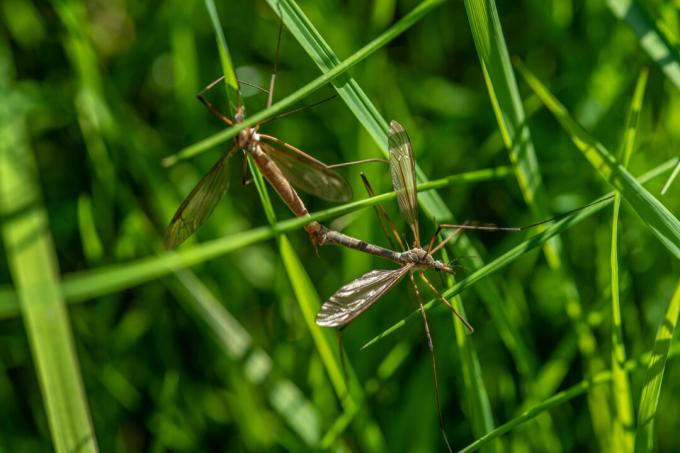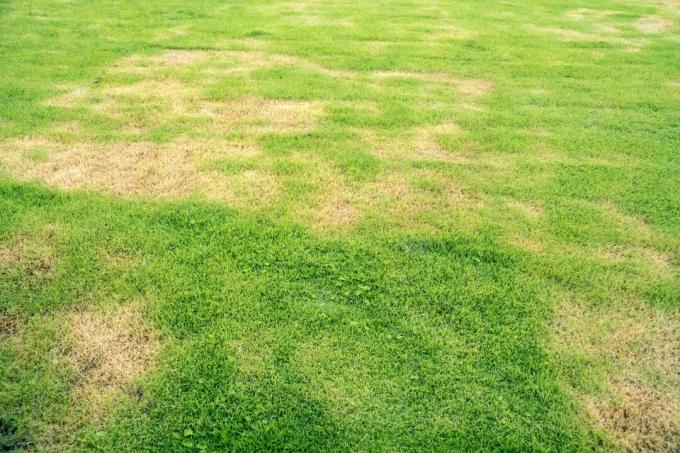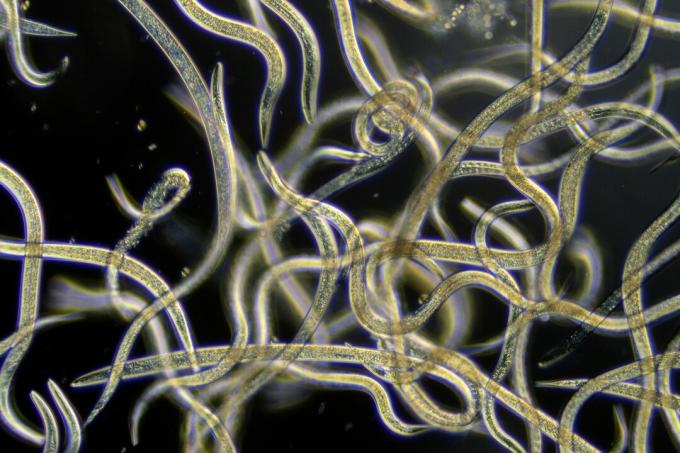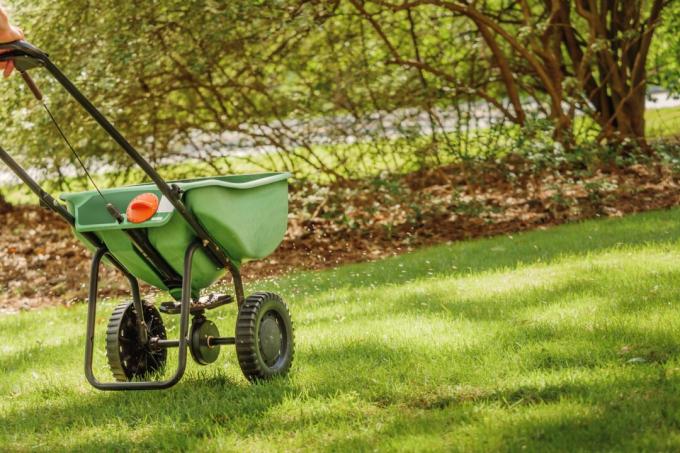Wiesenschnaken don't sting, but they can still cause a lot of damage. More precisely, it is their larvae that, in an emergency, can lead to the death of entire lawns.

Even if there are Wiesenschnaken (Tipula paludosa) are basically useful insects, a massive occurrence in the lawn can quickly become a problem. How to recognize the damage pattern, the adult animals and the larvae of meadow snakes as well as different ways of their environmentally friendly control can be found in this article.
contents
-
Recognizing Wiesenschnaken: way of life and damage
- way of life
- Damage
-
Fight meadow schnitzel
- Nematodes against meadow snake larvae
- Insecticides against meadow snakes
- Fight meadow schnitzel with calcium cyanamide
- Home remedies for meadow schnitzel
- Prevent infestation
Recognizing Wiesenschnaken: way of life and damage
Despite their second name - Swamp Schnake - you can find Wiesenschnaken mainly on fresh, medium-heavy, loamy soils with closed turf. It is fairly easy to spot flies and distinguish them from other insects and their larvae.
Adult meadow snakes are relatively large with a body length of up to 2.5 cm and a wingspan of 3 to 4 cm. The body of Tipula paludosa is solid gray-brown and elongated. Their legs are noticeably long and thin, and their wings are clear and not spotted. If you can observe a specimen more closely, you will notice a V-shaped seam on the back and the lack of point eyes between the compound eyes. As with all species of gnat, the mouthparts of meadow snakes are not suitable for stinging. Instead, the adult animals feed on water and nectar. So they are neither dangerous to us humans, nor do adult meadow snakes damage the lawn.
tip: Adult Wiesenschnaken can at first glance with the so-called Kohlschnaken (Tipula oleracea) can be confused. For a clear identification one has to catch a snake and look at its eyes. If they are close together and almost touching, it is a cabbage schnake. In the case of Wiesenschnaken, the distance is a lot larger.

Immediately after hatching in autumn, the larvae of the meadow snake are still very small. But they will grow to a size of up to 4 cm by next spring. The so-called "devil's face" is typical of Tipula larvae. If you look at the brownish-gray larva from behind, you can see a dark, hard plate that is surrounded by six white lobe-like appendages. It is a tool that is used for locomotion. However, it was interpreted by creative viewers as a face with two dark eyes and white horns. The actual head capsule has a solid structure and is very small. Furthermore, the larvae have neither legs nor any other appendages.
Tip: In spite of everything, it is very difficult to distinguish the larvae from other species of snake. However, the demarcation works well Grubswhich can also cause great damage in the lawn. The larvae of meadow snakes are significantly slimmer than white grubs and have no noticeable thickening or curvature of the body.

The pupae of the larvae during the resting stages are reddish-brown and divided into different segments, the rear of which have ring-shaped small thorns.
way of life
The adults hatch from the pupae around mid-August. Due to their short lifespan, meadow snakes start mating and laying eggs straight away. Since the females are only able to fly to a limited extent and can manage a maximum of five meters at a time, they can only be found near the habitats of larvae. A female lays 300 to 500 eggs and then dies relatively quickly. The first larvae hatch after 11 to 15 days. A total of four stages are passed through before pupation, two of them in autumn. The third larval stage occurs deeper in the soil and allows wintering below the frost line. In cold winters, up to 50 percent of the larvae can Tipula paludosa enter. However, if the winter was mild, most of them survive. In spring development continues with the last two larval stages. This is where the greatest damage is done, because in the final stage the larvae can be up to 4 cm long and are accordingly real wolverines.

Around the middle of May the meadow snake larvae reached their maximum size. Then they migrate deeper into the soil and place one about 3 to 5 cm below the surface of the soil Rest for about six weeks before they pupate and from mid-August as adult gnats Hatch. The Wiesenschnake manages one generation per year.
Damage
Already in autumn the young, small meadow snake larvae feed on grass roots and at night or on rainy days also on superficial parts of plants. The main damage occurs in spring, especially after mild winters. Then the large, large meadow snake larvae, which occur in large numbers, can uproot entire patches of lawn.
Typical signs of an infestation with meadow snake larvae are:
- Decreased growth
- Yellow-brown discoloration of leaves
- Wilting
- Nests of bald spots
- More birds on the lawn. They eat the larvae that live close to the surface of the soil and can further damage the grass through their scratching.

Difference to fungal diseases: In the case of a meadow snake infestation, the leaves turn uniformly brown and not blotchy. It looks as if the lawn is drying out in places.
If you are unsure, a simple groundbreaking at an affected area will help. In the event of an infestation, you should see the larvae directly, of which up to 600 per square meter can occur in severe cases.

At a glance: What do meadow snakes look like in the lawn?
- Adult gnats: Length: up to 1.8 cm (males), 2.5 cm (females); Wingspan: up to 3 cm; long, thin legs; monochrome, brownish-gray with clear, immaculate wings.
- Larvae: Brownish gray; up to 4 cm (in spring); sclerotized, small head capsule; "Devil's face" on the abdomen for locomotion.
- Dolls: Reddish brown; different segments, the posterior ones with small thorns.
- Damage: Wilting and brown discoloration of grasses through to nests of bald spots in the lawn.
Fight meadow schnitzel
Once you have discovered the first flies in your garden, the question quickly arises: “How do I fight Tipula larvae? in the lawn? ”The synthetic-chemical control of meadow snake larvae in the lawn has been around for some time forbidden. There are, however, a multitude of control options, some of which are very compatible with the environment and which leave other useful insects in the soil undamaged.

Nematodes against meadow snake larvae
Nematodes of the species Steinernema carpocapsae parasitize the larvae of meadow snakes and some other pests. The tiny nematodes, which cannot be seen with the naked eye, look for the larvae in the ground and penetrate them. There they continue to multiply and kill the meadow snake larvae in the process. It does this by releasing a bacterium, which in turn releases a toxin. The first successes of the treatment can be seen after just seven days. If the old larva no longer offers food, it is abandoned by the nematodes, which go in search of new hosts. This continues until they can no longer find any larvae and ultimately die themselves. The control of meadow snakes in the lawn with nematodes is a sustainable, chemical-free and harmless control method for humans and the environment. An efficiency of 80 to 90 percent can be achieved.

Fighting meadow snakes with nematodes only makes sense between mid-September and mid-October, so two to three weeks after the flight of the adults, the fully trained and sexually mature Insects. With increasing age, the larvae develop better defense mechanisms and become more and more resistant. During this period our Plantura SC nematodes used against mole crickets, meadow snakes and groundworms. A package with ten million nematodes is enough for around 20 square meters. The nematodes can be conveniently ordered and delivered to your home. They can be kept in the refrigerator for up to six weeks before use.
Tip: Choose a cloudy, rather rainy day for the application, as the nematodes are sensitive to UV radiation. The soil should also be kept moist afterwards, otherwise there is a risk that the nematodes will dry out.
Insecticides against meadow snakes
In general, no insecticides against meadow snakes are permitted in grassland or on lawns. Apart from that, these synthetic substances often impair other, useful insects as well as their intended effect. They can also have negative effects on us humans or pets. Fortunately, there is no need for insecticides against meadow snakes, as there are plenty of other ways to control it.
Fight meadow schnitzel with calcium cyanamide
The best effect with calcium cyanamide against Tipula is achieved when the fertilizer is applied in early spring, i.e. from around March. The younger the larvae are, the more sensitive they are. The floor temperature should already have reached 3 - 8 ° C. If 30 to 40 g of the fertilizer are then applied per square meter on rainy days, efficiencies of 40 to 60 percent can be achieved. But be careful, in the long run fertilizing with calcium cyanamide also has many disadvantages, as you can see in our special article Calcium cyanamide fertilizer can read.

Home remedies for meadow schnitzel
One can also act mechanically against the larvae, for example by rolling the lawn while the larvae are still in an early stage of development. Aerating rollers with spikes are particularly suitable here.
Scarifying Also causes lasting damage to the larvae, but also to the lawn. Therefore one should verticulate with a Overseeding combine.
You can also spread coasters with a bait mixture of ten parts of moist wheat bran and one part of sugar on small areas. The Tipula larvae in the lawn are strongly attracted by this, leave the ground and move into the saucers. There they can then be collected in the early hours of the morning. Pieces of black foil or plastic have a similar effect.
Finally, you can cover small lawns with a fleece as soon as you have discovered the first flying gnats in August. This prevents the flies from laying their eggs in this piece of lawn. It is important that the fleece is as light as possible and air and water permeable so that the lawn is damaged as little as possible. Only remove the fleece when mowing the lawn. The last adult animals die around the middle of September, so that the fleece can then be completely removed from the lawn.

At a glance: How can you combat meadow schnitzel?
- Countering meadow snakes with synthetic insecticides is not allowed.
- Nematodes are a sustainable, safe control option. The tiny nematodes kill meadow snake larvae in the lawn by parasitizing them.
- Fertilizing with calcium cyanamide can add to the meadow snake larvae, whereby calcium cyanamide is disadvantageous for the lawn in the long term.
- Rolling and scarifying can also kill meadow snake larvae.
- Bait traps attract larvae from the ground that can be collected.
- Small lawns can be covered with fleece.
Prevent infestation
Some of the measures mentioned above also serve to prevent meadow snake infestation. For example, you can prevent the laying of eggs by covering the lawn with fleece, foil or cardboard. Occasional rolling or scarifying also keeps them in check. In addition, the promotion of predators by meadow snakes counteracts an infestation of your lawn. This includes many birds such as blackbirds and starlings. Like your Make the garden more bird-friendly we have summarized them in a separate article.
A healthy, lush green lawn needs a lot of maintenance. Because not only pests, fertilization at the wrong time or incorrect mowing can also affect the lawn. Hence, it is important to know which ones Maintenance work for the lawn is due all year round and what you have to consider.



